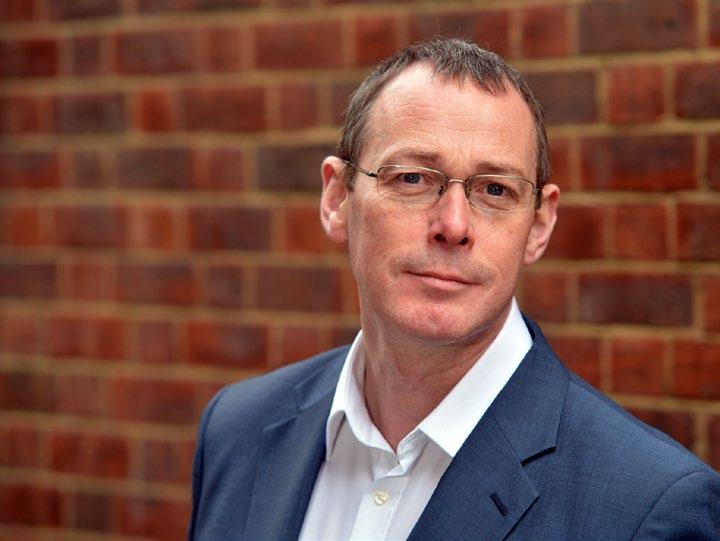
6 minute read
Young adult goes mainstream
Shows once aimed at under-25s are reaching beyond their target demographic, reports Harry Bennett
On the day before Netflix released the first series of Sex Education, Jamie Campbell, creative director of the producer, Eleven Film, recommended the series to his friend’s 18yearold daughter. As a highschool drama about the sexual misadventures of teenagers, Campbell assumed Sex Education would resonate with her. She agreed to call the next day to share her thoughts, but when she did, she said she hadn’t watched it.
Advertisement
When she got home, her mother, who was in her late fifties, had already started watching. Given the subject matter, she said she’d prefer to watch it in a parent free zone.
Campbell asked her if her mother had liked it: “She said, ‘The thing is, I got up the next day and my mum had stayed up until four in the morning to watch all the episodes.’”
Sex Education is just one of many youngadult series that are striking a chord with audiences older than the generation they depict. In the recent past, Normal People, I May Destroy You, Feel Good, Ackley Bridge and Industry have all won audiences in their millions.
The mainstream success of youngadult TV signals a change in viewing habits across all demographics. Arguably, it shows a growing sophistication among audiences, who increasingly discriminate more by quality than by genre. This has been matched by a change in programming across all channels to align with these new habits.
It is a trend that can be traced, in part, to the rise of the streaming and catchup services, where broadcasters can promote what were once regarded as niche shows to help them break through to mass viewership.
Netflix could reasonably claim to have been the prime mover in this paradigm shift. Unshackled from the linear schedule and the demands of advertisers, the streamer could afford to commission programmes for what, in the past, would have been niche audiences, and without, say, a specific age group in mind.
Netflix Sex Education
Young adult goes mainstream
“The process with Sex Education really bore that out,” says Campbell. “Netflix was not looking for a show that would cater to a particular demographic in a strict way. The thing it was interested in was executing the concept of the show in as authored and free a way as possible.”
The platform has, in fact, abandoned demographics altogether in favour of what Campbell describes as “taste communities” (groups of users sharing similar viewing histories). Even then, these aggregations are only used to drive users to new content.
With Sex Education, says Campbell, Netflix did what it does for every series. It put it out on the service indiscriminately at first, allowing time for data analysis to find the “communities” with which it resonated. Only once these had been identified did the streamer begin targeting, by positioning the series on the Netflix homepages of other members of those same “communities” – be they a 58yearold mother or her 18yearold daughter.
Targeting is one thing, consumption is another but, as Wayne Garvie, President of international production at Sony Pictures Television, points out, the bingeing enabled by streaming services promotes experimentation. Even if you don’t like the first episode of a series, the second is only an autoplay away – by which time you might be hooked. “With traditional free toair TV, you’ve got to come back to the same place in a week’s time. It doesn’t lend itself to trying out the esoteric and the eclectic,” he says.
A case in point is Alex Rider, Sony Pictures’ eightpart adaptation of Anthony Horowitz’s bestselling series of youngadult spy novels. Sony had fully funded the project but, when the company started selling the show, Garvie noted a problem – even though “everyone loved it”. What “became clear was that, if you were a linear broadcaster, you couldn’t work out where it would sit in the schedule”.
This is a serious issue for broadcasters, Garvie acknowledges, as “they are terrified of losing their core audience, which is always older than you think”. But he remembers a “big lesson” he learnt during his time at the BBC: 20 years ago, the most popular programme for young audiences was EastEnders. “It has always been a myth that you only watch people of your own age on screen.”
Alex Rider may be about an adolescent spy, but Sony’s research indicated that the series would bring in older viewers. Amazon Prime Video eventually secured the rights and, Garvie notes, “it has done exactly that”.
The times are changing, however, and, as Garvie observes, “broadcasters are slowly weaning themselves off the crack cocaine of a schedule. They can’t go cold turkey but, as they themselves
become digital channels, it’s going to change absolutely the kind of choices they make.”
Similarly, Campbell has noticed a “virtuous circle” at play in that, seeing the mainstream appeal of Sex Education on the streamers, linear broadcasters are “taking more of a chance on shows that would otherwise be traditionally ‘young adult’”.
Channel 4’s approach, says head of drama Caroline Hollick, is to commission series that, while they might have a younger focus or younger protagonists, their “storytelling has a sophistication and its themes and emotions have a universality to them”.
In so doing, Channel 4 can minimise the risk that Garvie referred to of losing the generally olderskewing core audience of a broadcaster.
Hollick credits Channel 4’s young adult drama Skins, which launched in 2007, with reinventing the genre and providing it with an authentic edge.
At the time, there was an abundance of youngadult series but, as the show’s cocreator Bryan Elsley recalls, “they were quite safe and anodyne”.
Elsley says that it was his son, Skins cowriter Jamie Brittain, who first alerted him to the gap in the market. “In all those shows, kids would have problems and they’d get worse and worse and worse and, eventually, they’d go to their mum or dad. So Jamie’s idea was: what if your mum and dad’s idea of a solution is fucking stupid?”
Elsley hired a team combining TV veterans and young newbies to ensure they could write authentically about the thornier (and hornier) side of teenagehood. Sexuality, gender, mental

health, substance abuse – no issue was off limits, and the sixth formers at Skins’ centre were left to their own devices to tackle them.
The result was a winning rejoinder to the conventional youngadult fare of the time, as Skins removed the gloss and applied grit to the genre.
Today’s youngadult shows invariably tackle tough themes and, in doing so, can break through to mainstream audiences – provided that they are marketed cleverly or algorithmically targeted.
Consider such recent shows as I May Destroy You, The End of the F***ing World, Normal People, Ackley Bridge and, of course, Sex Education. The stories are told inclusively and the series are targeted indiscriminately. Viewers young and old are spoiled rotten, so is it any surprise that so many of us are tuning in? n
Skins
Channel 4










